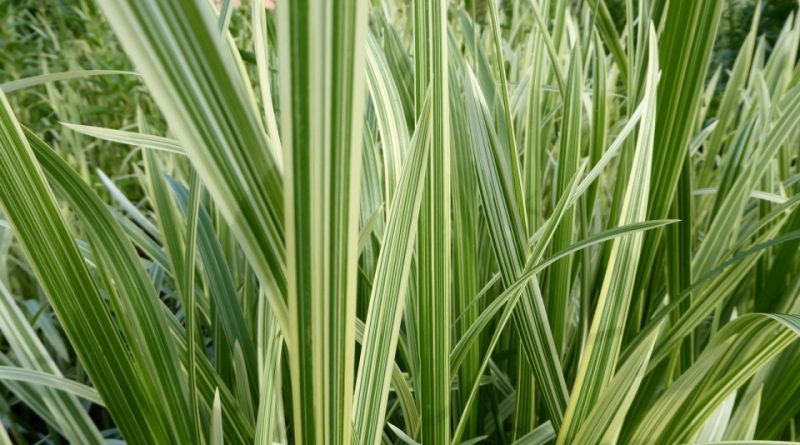Glyceria maxima variegata
Glyceria maxima variegata
The Glyceria maxima variegata is a variety of the Glyceria maxima (Glyceria maxima (Hartm.) Holmb., 1919) and therefore belonging to the Poaceae family.
Systematic –
From a systematic point of view, it belongs to the Eukaryota Domain, Plantae Kingdom, Subregion Tracheobionta, Spermatophyta Superdivision, Magnoliophyta Division, Liliopsida Class, Commelinidae Subclass, Cyperales Order, Poaceae Family, Pooideae Subfamily, Meliceae Tribe and therefore to the Genus Glyceria, to the Species G max. and to Variety G. m. varied.
Etymology –
The term Glyceria comes from the Greek sweet, lovable γλῠκ amς glycýs.
The specific epithet maxima is the superlative of magnus grande: maximum, the largest, for the dimensions compared to those of the congenital species.
The variegated name comes from various variations, to be of different colors: variegated, striped, mottled, colorful.
Geographical Distribution and Habitat –
The Glyceria maxima variegata is a variety of the Gliceria maggiore which is a plant of a rather large area, typical of the cold and temperate-cold areas of Europe, Asia and North America.
Description –
Glyceria maxima variegata is a grass, characterized by a cream-yellow striped foliage, which forms thick tufts and reaches a maximum height of 60 cm – 75 cm.
The stems are erect or slightly inclined that start from submerged rhizomatous roots.
In summer, thin spikes formed by small flowers emerge from the apex of the stems, followed by small elongated seeds.
Sometimes submerged stems root in the internodes.
The flowering period is between July and August.
Cultivation –
The Glyceria maxima variegata is a perennial aquatic ornamental plant, suitable for all types of pond and not very invasive.
It should be grown at the edge of the ponds, immersed for a maximum of 10 cm of water, on neutral soil, even calcareous and gravelly in a sunny position.
It is a very rustic plant, it resists the summer heat and winter temperatures down to -20 ° C.
It prefers very humid and loves fresh, moist soil or immersed in water.
As exposure it prefers the sunny one and to give a good result it must be planted with a density of 3 seedlings per m2.
The planting depth between the rhizome and the surface of the water must be from 0 to -10 cm.
Uses and Traditions –
The Glyceria maxima variegata is a marsh graminaceous plant that forms dense tufts of variegated green-cream yellow color.
It is frequently used as an ornamental plant on the banks of ponds or for phytodepuration plants. In summer it develops an inflorescence made up of many ears.
In nature it is often found on the banks of lakes, rivers or small bodies of water.
Method of Preparation –
In addition to the ornamental uses or for use in phytodepuration plants, no other noteworthy uses are known.
Guido Bissanti
Sources
– Acta Plantarum – Flora of the Italian Regions.
– Wikipedia, the free encyclopedia.
– Treben M., 2000. Health from the Lord’s Pharmacy, Tips and experiences with medicinal herbs, Ennsthaler Editore
– Pignatti S., 1982. Flora of Italy, Edagricole, Bologna.
– Conti F., Abbate G., Alessandrini A., Blasi C. (edited by), 2005. An annotated checklist of the Italian vascular flora, Palombi Editore.
Warning: Pharmaceutical applications and alimurgical uses are indicated for information purposes only, they do not in any way represent a medical prescription; therefore, no responsibility is accepted for their use for healing, aesthetic or food purposes.


